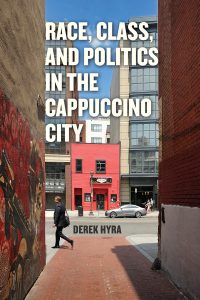Derek Hyra on gentrification and neighborhood perception in DC

From a recent interview with Derek Hyra at CityLab—based on his latest book Race, Class, and Politics in the Cappuccino City—on the diminishing returns of gentrification in DC’s Shaw/U Street neighborhood.
***
In the book, you talk about how the black history of the neighborhood is being leveraged to advertise it to young urbanites. Could you talk about that?
In the 1950s, ‘60s, ‘70s, and ‘80s, if a neighborhood was branded black, it usually led to economic decline and white flight. And in the ‘90s and 2000s, you see low-income African-American neighborhoods being branded black and yet attracting whites. That is the unique dynamic of the Shaw-U Street area. Many of the developers are branding the buildings after iconic African Americans. There’s the Langston Lofts, there’s the Ellington Apartments. There’s Marvin’s, which is a restaurant that’s named after Marvin Gaye, who grew up in Washington, D.C. There’s Busboys and Poets, Andy Shallal’s restaurant, named after Langston Hughes, which is very well-known in the D.C. area and also around the country. There’s also a historic walking trail, and you can see where Alain Locke, who wrote The New Negro—the philosophy of the Harlem Renaissance—lived. There’s historic preservation related to this community’s black history that is appreciated by whites and some whites are moving to this area because it is a diverse area.
But I also write that some whites are moving to the area because they know it was once the former ghetto. They know 14th Street used to be an open air drug market in the ‘80s and early ‘90s. And some white residents are looking for racial stereotypes. They’re looking for the iconic ghetto. They’ve seen shows like The Wire, and maybe New Jack City or Boyz N The Hood, and they have a connotation of what inner-city African-American areas that were once low-income look like. They’re actually moving here, in part, because they think that they’re moving to an area that they consider “authentic.” It’s not a homogenous affluent white area. It’s not in Georgetown. It’s not Foggy Bottom. It’s not Dupont Circle: It’s Shaw-U Street.
Elaborate on what’s positive and what’s problematic about this change, and with this perception of the neighborhood.
We have been so segregated in the United States and that now that whites are attracted and willing to move into what was formerly a low-income African-American neighborhood does symbolize some progress, in terms of race relations in the United States. That we have mixed-income, mixed-race neighborhoods, I think, is a very positive thing.
But that diversity not necessarily benefiting the former residents. Most of the mechanisms by which low-income people would benefit from this change are related to social interaction—that low-, middle-, and upper-income people would start to talk to one another. They would problem solve with one another. They would all get involved civically together to bolster their political power. But what we’re really seeing is a micro-level segregation. You see diversity along race, class, sexual orientation overall, but when you get into the civic institutions—the churches, the recreation centers, the restaurants, the clubs, the coffee shops—most of them are segregated. So you’re not getting a meaningful interaction across race, class, and difference. If we think that mixed-income, mixed-race communities are the panacea for poverty, they’re not.
During my research, for example, I had a lot of people tell me that they were pleased with the redevelopment because they felt it was associated with reductions in crime. They felt that it would be safer for their kids and their families. But then I would say, “What else is happening in this neighborhood?” “Oh well, the amenities are coming in that we can’t utilize or don’t want to utilize them.” “We’re losing our political power, because most of the civic associations used to be African-American, and then flipped.” So there’s a political loss that’s also occurring.
And then also you’ve got some people in this community that I say in the book are “living The Wire”—looking for iconic ghetto stereotypes. Some newcomers thought it was hip and cool, that it actually brought them more credibility because they were living in a neighborhood that was edgy and rough. Crime and blackness is associated in the minds of some newcomers—and that’s really problematic. Low-income residents, on the other hand, think crime is detrimental to their kids’ opportunities and to their health.
Sociologist Robert Sampson writes a lot about collective efficacy: that controlling crime brings people together across difference, as a community. But in a place where crime is perceived differently by a long term and newcomer populations, that’s not going to happen.
***
To read the interview in full at CityLab, click here.
To read more about Race, Class, and Politics in the Cappuccino City, click here.